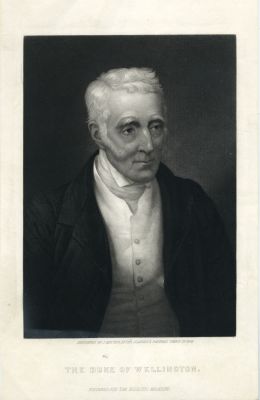
Title
Field Marshal The Duke of Wellington, K.G.Artist
Claudet, Antoine (French, 1797-1867)Date
1844 negative, 1845 printProcess
Engraving (from photograph)Atelier
RyallImage Size
33.2 x 25.6 cmSheet Size
56 x 43.5 cm
Stipple Engraving based on a painting by Abraham Solomon based on a daguerreotype made at Claudet’s London Studio on May 1, 1844.
Before the advent of photomechanical reproduction, early daguerreotypes were regularly reproduced manually in other media, particularly engraving. The accuracy of the reproduction depended heavily on the skill of the engraver and only rarely did the engraved interpretation effectively translate the nuance of the original photograph. A good example is the daguerreotype image of Arthur Wellesley, the Duke of Wellington taken at Antoine Claudet’s studio. The photograph shows the Duke, then 75, sitting against a plain background and looking to his right, beyond the camera. It was made May 22, 1845, on the occasion of the Duke’s birthday.
In 1845 the daguerreotype was sold to publisher James Watson. Watson then lent it to the painter Abraham Solomon, who used it to produce an enlarged oil-painted portrait of the Duke. Both this painting and the daguerreotype were subsequently lent to Henry Thomas Ryall, who used them to make a steel engraving. The engraving faithfully imitates the composition and details of the daguerreotype, but reverses the orientation of the Duke’s body so he is now looking off to his left. Supposedly a simple result of the union of science with art, this particular image was described by the reporter for the Times as a likeness surpassing in fidelity both the original daguerreotype and the painted copy; in short, a likeness so true to nature and so complete a translation of the features, character, and very look of the illustrious Duke, that nothing but the reflection of the face of his Grace in a mirror can surpass it. A story in the Illustrated London News, published a few years later on November 13, 1852, tells us that the Duke himself was not particularly impressed by the print, perhaps because it was indeed "so true to nature": Apparently, he looked at it for a moment, shook his head, and, with a half smile and half frown of recognition, muttered ‘Very old! Hum!’ and turned away in thought. Over the ensuing years the portrait appeared in multiple publications in many media. So much so that the Illustrated London News published a survey of them in 1852. [1]
Examining the multiple examples of the translation of Claudet’s daguerreotype that appeared in books and the press in the mid 19th century reveals the limitations of the manual translation of the daguerreotype onto the printed page. Each iteration of this image has its own distinctive pictorial qualities but each is also inhabited by the absent presence of Claudet’s original photograph, for it is this which gives the Duke’s portrait its presumed authenticity and allure. [2]
Banker and businessman Antoine Claudet learned of the new daguerreotype process in 1839 from its inventor Jacques Louis Mandé Daguerre. Claudet promptly purchased a license to practice the fledgling art. He opened his studio in 1841 and became one of only two operators of daguerreotype studios in England. Claudet actively experimented with the daguerreotype medium, becoming one of the first practitioners to significantly reduce exposure times. He joined the Royal Photographic Society in 1853. In the 1850s he moved on to the calotype and wet-collodion processes, then specialized in stereograph views in later years. [3]
Reproduced / Exhibited
Gernsheim, Helmut, and Alison Gernsheim. L.j.m. Daguerre (1787-1851): The World’s First Photographer. Cleveland: World Pub. Co, 1956. pl. 82
Geoffrey Batchen Apparitions, The Photograph and its Image, Adam Art Gallery, Victoria University of Wellington, New Zealand, 2017, pg 31
Geoffrey Batchen, Apparitions Photography and Dissemination, Power Publications, Sydney, 2018, fig 62
References
[1] [2] Geoffrey Batchen Apparitions, The Photograph and its Image, Adam Art Gallery, Victoria University of Wellington, New Zealand, 2017
Geoffrey Batchen, Apparitions Photography and Dissemination, Power Publications, Sydney, 2018
Geoffrey Batchen, ‘Double Displacement: Photography and Dissemination’, in Thierry Gervais ed., The ‘Public’ Life of Photographs (Toronto: Ryerson Image Center/The MIT Press, 2016), 38-73
[3] Gernsheim, Helmut, and Alison Gernsheim. L.j.m. Daguerre (1787-1851): The World’s First Photographer. Cleveland: World Pub. Co, 1956. pl. 82



